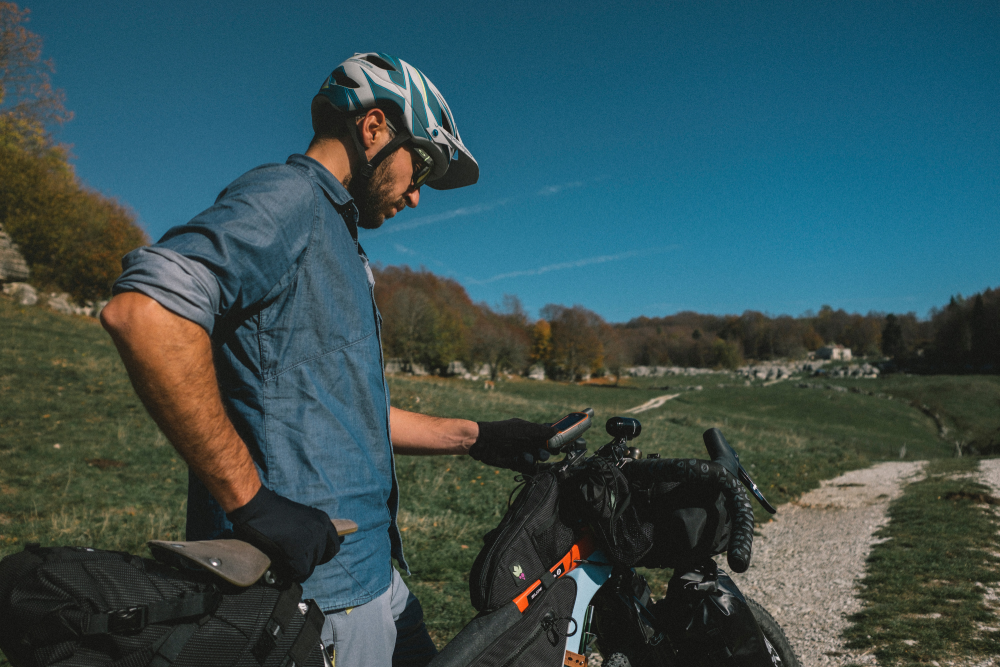
Are you looking for where to plan your next bike tour? Look no further than Portugal and Southwest Spain! This part of Europe offers some of the most diverse and beautiful landscapes for bicycle touring. From the rolling hills of the Douro Valley to the rugged coastline of the Algarve, to the culinary hotspot of Seville, the region is a cyclist’s paradise.
But it’s not just the picturesque landscapes that make Portugal and Spain a must-see destination for bicycle touring. The region is also home to a rich culture and history, with charming villages and bustling cities to explore. And let’s not forget the delicious food and wine! The Iberian Peninsula is known for its incredible food and wine, making it the perfect destination for foodies looking to indulge while on tour.
One of the best things about bicycle touring in Portugal and Spain is the accessibility and convenience of the country. The whole region has a well-developed network of bike paths and quiet roads, making it easy for cyclists of all skill levels to navigate. Plus, with a relatively mild climate and friendly locals, you can’t go wrong with a tour in the region.
But perhaps the greatest appeal of bicycle touring is the sense of freedom and adventure that comes with exploring these beautiful countries on two wheels. Whether you’re a seasoned cyclist or just starting out, a tour there will leave you with lasting memories and a newfound appreciation for the simple joys of bicycle travel. So pack your bags, grab your bike, and get ready for an unforgettable adventure!
Why do it? — Physical and Mental wellbeing:
Long-distance bicycle touring is a great way to improve both physical and mental wellbeing. The physical benefits of cycling are well-known, such as improved cardiovascular health, increased muscle strength and endurance, and weight loss. But the mental benefits of long-distance bicycle touring go beyond just the physical benefits.
First, long-distance bicycle touring allows for a sense of accomplishment and self-reliance. Setting a goal and completing a long-distance tour can boost self-confidence and self-esteem. The sense of accomplishment from completing a challenging journey is a great feeling and can serve as a reminder of one’s own strength and resilience.
Long-distance bicycle touring allows for a disconnection from daily life and technology. It can be a way to unplug and disconnect from the constant stimulation of technology, social media, and the fast-paced nature of modern life. This disconnection can lead to a sense of calm and clarity, allowing for improved focus and concentration when returning to daily life.
Another reason to do it is that long-distance bicycle touring allows for the opportunity to explore new places, meet new people, and experience new cultures. These experiences can broaden one’s perspective and help to reduce feelings of stress, anxiety, and depression.
Long-distance bicycle touring can also increase social connections, as it is often done in groups, touring with friends or as part of an organized tour. This can help to alleviate feelings of loneliness and isolation.
Overall, long-distance bicycle touring offers a unique combination of physical and mental benefits, making it an excellent way to improve overall wellbeing and happiness.
Character Building — Self-Development:
Long-distance bicycle touring can be a challenging and demanding experience that can help to develop a strong character and a positive outlook on life. It’s much more than just a physical activity. It can also provide valuable life lessons and personal growth. Here are some of the benefits of bicycle touring beyond the physical challenge:
Resilience is an essential quality that can be developed through bicycle touring. When faced with challenges and obstacles, such as difficult terrain or inclement weather, riders must push through and persevere. Overcoming these challenges can help to build resilience and the ability to handle difficult situations in the future.
Adaptability is crucial in bicycle touring. Cyclists must be prepared to adapt to changing conditions, whether it’s unexpected detours or poor road conditions. This ability to adapt to unexpected challenges can help to develop flexibility and resourcefulness in other areas of life.
Patience is a valuable skill developed through long-distance bicycle touring. The journey can take weeks or months to complete, requiring a great deal of patience, both with oneself and with others. Developing patience can help to improve relationships and overall life satisfaction.
Perseverance is another benefit of bicycle touring. It can be challenging, and riders may feel discouraged at times. But pushing through the tough times and continuing to ride can help to develop perseverance and grit, which can be applied to other areas of life.
Bicycle touring provides an opportunity for appreciation of the world around us. Cyclists can see new places, experience different cultures, and meet new people, leading to a broader perspective and a deeper appreciation for the world around us.
Self-reflection is an essential aspect of bicycle touring. The solitude and quiet time can provide an opportunity for self-reflection, leading to a deeper understanding of oneself and one’s place in the world. This can lead to a more positive outlook on life.

Long-distance bicycle touring can be a challenging but rewarding experience that can help to develop a strong character and a positive outlook on life by building resilience, adaptability, patience, perseverance, appreciation, and self-reflection.
Planning:
When planning a long-distance bicycle tour of Portugal (and Spain), there are a few key things to be aware of to ensure a successful and enjoyable trip. Here is a list of considerations to keep in mind:
First and foremost, make sure you plan your route carefully. With the diverse range of landscapes and terrain, you’ll want to consider factors like elevation, road conditions, and traffic when choosing your path. It’s also a good idea to research the availability of accommodations and services along the way.
The weather can be variable depending on the region, so be sure to check the forecast and pack accordingly. Rain gear and warm layers are essential, especially during the cooler months. While the whole region has a relatively low crime rate, it’s still important to take precautions to keep yourself and your belongings safe. Use lockable panniers or a bike lock when leaving your bike unattended and be always aware of your surroundings.
Have the right bicycle bags, panniers and camping gear to make your trip enjoyable and also efficient. Pack light but the ability to carry with you the what you need to make the trip possible is essential.
Portuguese is the official language of Portugal and obviously Spanish for Spain, so it’s helpful to have some basic knowledge of the language to communicate with locals. Downloading a translation app or carrying a pocket dictionary can also be helpful.
It’s important to have your bike serviced before departing on your tour, and to carry spare parts and tools with you in case of basic repairs. Research accommodations ahead of time and book in advance, especially during peak travel seasons.
Portugal is known for its delicious cuisine, so take advantage of local food and drink options along the way. However, be sure to carry enough food and water to sustain you during long days of cycling.
Portugal’s road signs and markings can be inconsistent, so it’s important to have a reliable map or GPS device to navigate. If you’re a non-EU citizen, check visa requirements before you travel.
Lastly, make sure you have adequate travel and medical insurance coverage for your trip, so you can have peace of mind and protection in case of accidents or emergencies.
Training (Physical and Mental):
Here are some tips for physically and mentally preparing for a multi-week, long distance, self-supported bicycle tour of Europe:
Physical preparation:
Building a strong base of endurance is essential. Regular cycling or other endurance-based activities should be part of your training regimen. Start by aiming for at least 20–30 miles per ride, gradually increasing your mileage over time.
To take your training to the next level, incorporate interval training and hill climbs to improve your overall fitness and power. This will help you tackle the challenging terrain and keep up with the demands of a long tour.
As you approach your tour start date, gradually increase your weekly mileage and the duration of your rides. This will help to simulate the physical demands of a multi-week tour and prepare your body for the challenge ahead.
Don’t forget to pay attention to your core and upper body strength as well. This will improve your overall stability and help you handle the weight of your gear.
Make sure to include rest and recovery time in your training schedule. This will not only prevent injury, but also allow your body to recover and become stronger. Always remember to stay well hydrated and be mindful of your nutrition during the tour.
Taking care physically preparing yourself will go a long way to a successful and enjoyable cycling tour.
Mental preparation:
It’s important to set clear goals for your tour and develop a plan to achieve them. This will help you stay motivated and focused throughout your journey. You’ll also want to learn to be comfortable with being alone, as you will be on your own for extended periods of time.
Next, it’s important to learn to navigate using maps and a compass and familiarize yourself with the areas you will be traveling through. Practice problem-solving and decision-making skills to handle unexpected situations, and learn to be adaptable and flexible, as your itinerary may change due to unforeseen circumstances.
Developing a positive attitude and learning to manage stress will also be key to a successful tour. Be prepared for the physical and mental challenges that come with cycling long distances, and make sure to include rest and recovery time in your schedule.
Especially on the longer trips, get used to camping and cooking your own meals. This will help you save money and enjoy the great outdoors. Plus, there’s nothing quite like a tasty meal that will replenish your depleted energy after a long day on the bike.
Properly preparing yourself both physically and mentally will ensure that you have an unforgettable journey.
Bicycle Repair Skills:
The Basics
Before you go, be aware of the basic bicycle maintenance skills that are important to master to be able to conduct repairs while on a long-distance bicycle tour:
- Changing a flat tire: This includes removing the wheel, patching or replacing the inner tube, and re-installing the wheel.
- Adjusting brakes: This includes adjusting the brake pads, aligning the brake calipers, and adjusting the brake cables.
- Adjusting gears: This includes adjusting the derailleur, changing the cable and making sure the gears are shifting smoothly.
- Lubrication: This includes lubricating the chain, cables, and other moving parts to ensure smooth operation and prolong the life of the components.
- Tightening bolts and nuts: This includes tightening the handlebar stem, seat post, and other bolts to ensure that the bike is safe to ride.
- Cleaning the bike: Keeping the bike clean can help prolong the life of the components and make repairs easier to diagnose.
- Safety check: Before riding a bike, it is important to check the brakes, tires, quick release, to make sure everything is tight and secure.
Note that while being able to perform these basic repairs can be helpful while on a long-distance bicycle tour, it’s also a good idea to bring along a repair kit that includes spare tubes, a pump, and basic tools like a multi-tool, tire levers and a chain tool.
Advanced
Here is a list of advanced bicycle maintenance skills that can be useful for conducting repairs while on a longer distance bicycle tour, especially if you will be far from bicycle shops along the way:
First up is wheel truing, which involves adjusting spoke tension to keep your wheel running straight and true. It’s crucial to know how to do this, as a wobbly wheel can cause unnecessary wear and tear on your bike.
Next, understanding how to overhaul your bike’s hubs and bottom bracket can help prevent damage to these critical components. Regular cleaning and maintenance can go a long way in keeping your bike running smoothly.
It’s also important to know how to adjust your derailleur, including the limit screws, cable tension, and barrel adjuster, to keep your bike shifting efficiently.
Bleeding hydraulic brakes is another important skill to have, as it ensures your brakes maintain stopping power throughout your tour.
Proper headset adjustment can prevent wobbling and improve handling, while chain maintenance can prolong the life of your bike’s chain, cassette, and chainring.
Knowing how to set up tubeless tires and fix common issues can save you from dealing with punctures on the road.
Lastly, basic welding skills can be a lifesaver in the event of unexpected frame damage.
By mastering these skills, you will be able to conduct many repairs on your own while on a tour, which can save you from having to rely on outside help which may simply not be available and get you back on the road quickly.
An overview of touring Portugal and Spain — Traveling North to south:
Once you are prepared and planned the basics, what can you expect on your trip?
It’s an absolute joy to bike tour Portugal and Spain. There is way too much to see and do on just one trip so the following will just touch on the basics, based on a self-guided and self-supported trip I do recently. There are many routes to take so we will just touch on some of the many options you have.
Portugal and Spain are two countries known for their picturesque landscapes and rich cultural heritage, making them a perfect destination for a bicycle tour. The route from Porto to Seville is particularly spectacular, as it winds its way through rolling hills, charming villages, and historic cities.

Starting in Porto, a city known for its wine and historic architecture, cyclists can embark on a journey south towards Seville, one of Spain’s most vibrant and cultural cities. Along the way, they will pass through the Minho region of Portugal, known for its lush green landscapes and terraced vineyards. The route also takes cyclists through the Douro Valley, a UNESCO World Heritage Site famous for its wine production.
As you continue south, you’ll cross the border into Spain and pass through the provinces of Galicia and Extremadura. The landscapes in this region are characterized by rolling hills, forests, and meadows, providing a perfect setting for a relaxing ride. Along the way, you’ll have the opportunity to stop in charming villages and small towns, such as Tui, Monforte de Lemos, and Plasencia, each with their own unique history and culture.
Of time permits and you can work it into your itinerary, one of the highlights of this route is the chance to visit Santiago de Compostela, a city known for its historic cathedral and pilgrimage route. Many cyclists choose to take a break here and explore the city’s historic center, which is home to numerous museums, art galleries, and restaurants.
As you continue south, you’ll pass through the provinces of Castilla y Leon and Andalusia, known for their diverse landscapes and rich cultural heritage. Along the way, you can visit the city of Salamanca, known for its well-preserved medieval architecture and UNESCO World Heritage-listed university. The route also takes cyclists through the Sierra de Gredos, a mountain range known for its rugged beauty and excellent hiking trails.
Finally, the route ends in Seville, a city known for its lively atmosphere and rich cultural heritage. With its historic architecture, museums, and lively nightlife, Seville is the perfect place to end a bicycle tour. Along the way, you can also enjoy delicious local food and wine, and take in the sights and sounds of the region.
A bicycle tour from Porto to Seville is a journey that takes you through some of the most beautiful and culturally rich regions of Portugal and Spain. With rolling hills, charming villages, and historic cities, this route offers something for everyone and is a truly unforgettable experience.
Visit Porto:
Great, Porto is a wonderful city to explore by bicycle. One must-see destination is the Ribeira neighborhood, which is located along the Douro River and is a UNESCO World Heritage Site. The area is known for its colorful houses, charming narrow streets, and excellent seafood restaurants. Another great option is to take a bike ride along the Atlantic coast and visit the beaches of Foz and Matosinhos. Both are easily accessible by bike and offer stunning views of the Atlantic Ocean. If you’re looking for a more challenging ride, you can also cycle up to the top of the Serra do Pilar viewpoint, which offers panoramic views of the city and the river. Additionally, you can also visit the Palácio de Cristal, the Jardins do Palácio de Cristal or the Parque da Cidade.
Visit Lisbon:
Lisbon as lots of bike-friendly streets and bike lanes, making the area a pleasure to bike in. Here are a few highlights and places to visit by bike in Lisbon:
● The historic neighborhood of Alfama is a must-see destination, known for its winding streets, colorful houses, and historic landmarks such as the São Jorge Castle and the Se Cathedral.
● Another great option is to take a bike ride along the waterfront, known as the “Lisbon Riverside,” which offers beautiful views of the River Tejo and the 25 de Abril Bridge.
● The Belém neighborhood is another great destination, located just a short bike ride west of the city center. It’s known for its historic monuments and landmarks such as the Jeronimos Monastery and the Belem Tower, both of which are UNESCO World Heritage Sites.
● The Parque das Nações is a great destination. It’s a modern neighborhood located on the northeastern edge of the city, built for the 1998 World Exposition. It features a bike path along the waterfront and is home to the Lisbon Oceanarium, which is the largest indoor aquarium in Europe.
● Additionally, you can also visit the Lisbon Botanical Garden, the National Museum of Ancient Art, and the National Coach Museum.
It’s important to note that Lisbon is a hilly city, so some areas may be more challenging to bike than others. There are guided bike tours available which can help you navigate the city and see the most popular sights.
Visit the Algarve:
The Algarve is a great destination for cycling, with a mix of flat coastal areas and hilly inland regions. Here are a few highlights and places to visit by bike in the Algarve:
The Ria Formosa Natural Park is a must-see, boasting beautiful beaches, wetlands, and wildlife. The park is easily accessible by bike, with a flat and easy bike path running through it.
For those looking for some history and culture, the charming town of Tavira is a great place to start. This picturesque town, located on the eastern side of the Algarve, is known for its historic castle, churches, and charming streets.
The town of Silves is another gem, located in the western part of the region. It boasts a medieval castle and cathedral, as well as the charming streets of the old town. For those looking for a beach day, the town of Lagos offers beautiful beaches and a well-preserved old town with several historic churches.
One of the highlights of the region is the Cape of Saint Vincent, the westernmost point of mainland Portugal. It offers stunning landscapes and charming villages to cycle through. The cape is also home to a historic fort and lighthouse, making it a perfect spot for sightseeing and taking in the beautiful scenery.
And of course, no trip to the Algarve would be complete without exploring its coastline. From the wild cliffs and clear waters of the west to the white sandy beaches of the east, and the calm waters of the Ria Formosa, there’s something for everyone. So grab your bike and get ready to explore this beautiful region!
It’s important to note that the Algarve can be quite hilly, and depending on the section of the route you are on, the terrain may be more challenging, so it’s important to check the route in advance and plan accordingly. It is also recommended to bring sunscreen, plenty of water and a hat to protect from the sun. Also, while cycling on the Algarve’s coastline, you should be aware of the strong winds that can occur, especially in the afternoons.
Visit Seville, Spain:
Seville is a great destination for cycling, mostly flat and plenty of historical and cultural sights to see and fabulous food to eat.
Here are a few highlights and places to visit by bike in Seville:
● The historic center of Seville: The city’s historic center is a UNESCO World Heritage Site and is known for its beautiful architecture, including the famous Cathedral of Seville, the Giralda tower, and the Alcazar Palace.
● The Parque de Maria Luisa: This beautiful park is in the heart of Seville and is known for its lush gardens, fountains, and sculptures. It’s a great place to take a leisurely bike ride and relax.
● The Triana neighborhood: Located across the Guadalquivir River from the historic center, Triana is known for its colorful streets and lively atmosphere, and it’s a great place to explore by bike.
● The Isla de la Cartuja: This island is in the Guadalquivir River and is home to the Cartuja Monastery, which was built in the 15th century. The island also offers a great opportunity to cycle along the river and enjoy the views of the city.
● The Metropol Parasol: Also known as the mushrooms, this modern architectural structure is in the heart of the city and offers great views of the city from the top.
● The Guadalquivir river side: The river side is a great place to cycle along, it offers a beautiful view of the city and the possibility of enjoy the sunset.
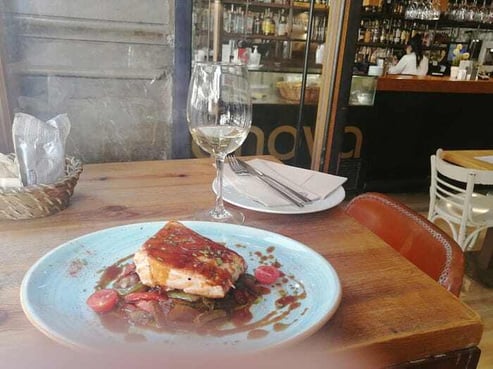
Seville is located in one of the hottest regions of Spain, so it’s recommended to bring sunscreen, plenty of water and a hat to protect from the sun, especially during the summer months.
Famous Cycling Routes: The EuroVelo1:
The EuroVelo 1, also known as the Atlantic Coast Route, runs along the entire coast of Portugal, starting in the north at the border with Galicia, Spain and ending in the Algarve region in the south. The route offers a diverse range of landscapes and experiences, from the rugged cliffs of the north to the sandy beaches of the south.
Here are a few highlights along the route:
The cycling route starts in the north and takes you through the Minho region, famous for its charming villages and Vinho Verde wine. As you cycle further south, you’ll pass through the cities of Viana do Castelo and Porto, both with incredible cultural and historical significance.
In the central region, the route takes you through the picturesque city of Aveiro, known as the “Portuguese Venice,” where you can cruise the canals on colorful boats called moliceiros. The historic city of Coimbra, home to one of the oldest universities in Europe and a UNESCO World Heritage Site, is also along the way.
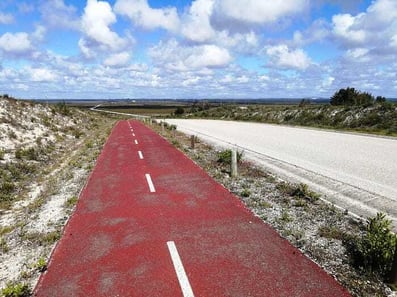
As you venture south, you’ll be greeted with stunning beaches along the Costa de Prata, including Figueira da Foz and Nazaré. The medieval castle in Leiria and the Sanctuary of Fatima, a significant pilgrimage site, are must-sees. The southernmost portion of the route takes you through the renowned Algarve region, famous for its sun-kissed beaches and rocky coastline. Take a dip in the ocean and soak up the sun in the towns of Albufeira, Lagos, and Sagres.
Along the way, you’ll have the chance to explore the Ria de Aveiro Natural Park and the Serra da Arrábida Natural Park, both with breathtaking views of the sea and nature. Whether you’re an experienced cyclist or a casual rider, this route offers an unforgettable adventure through Portugal’s diverse regions.
Note that the EuroVelo 1 route runs through many towns and cities, and depending on the exact section of the route you are on, the terrain may be more or less challenging. Therefore, it’s important to check the route in advance and plan accordingly.
Famous Cycling Routes: The Estrada Nacional 2:
The Estrada Nacional 2, or N2, is a highway in Portugal that runs from the border with Spain in the north to the city of Faro in the south. The N2 is an important historical route in Portugal, as it was one of the main roads used to connect the north and south of the country for centuries.
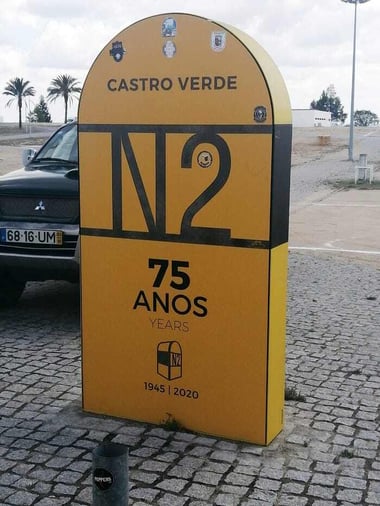
While cycling along the N2, you will have the opportunity to see some of the most beautiful landscapes in Portugal, including the Serra da Estrela, the Serra do Açor and the Serra do Caldeirão. Here are a few highlights along the route:
The Serra da Estrela Natural Park is the highest mountain range in mainland Portugal and is a must-visit for any cycling enthusiast. The park is full of beautiful landscapes and charming villages that you can explore on two wheels. The Torre, the highest point in mainland Portugal, is also located here, and it’s a great spot to take in the stunning views.
Coimbra is another city that should be on your list. It’s famous for its historic university, which dates to the 13th century, and for the Biblioteca Joanina, a stunning baroque library that is considered one of the most beautiful in the world. If you’re interested in history and culture, this city is worth a visit.
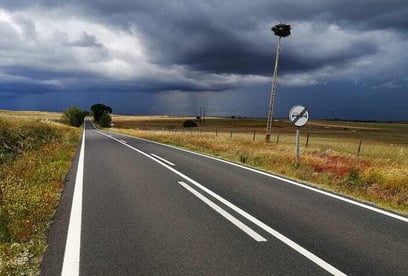
Tomar is a small town located in the central region of Portugal, and it’s known for its historic castle and the Convent of Christ, a UNESCO World Heritage Site. If you’re interested in medieval history, this is a must-visit destination.
Évora is another city that you shouldn’t miss. Located in the Alentejo region, it’s known for its well-preserved Roman and medieval architecture, including the Temple of Diana and the Cathedral of Évora. This is a great place to learn about Portugal’s rich history and admire its beautiful architecture.
Finally, the Algarve region is a must-visit for anyone who loves the beach. This region is known for its beautiful beaches and cliffs, and it’s a popular tourist destination that offers plenty of activities such as swimming, sunbathing, and other beach activities. Whether you’re looking for relaxation or adventure, the Algarve has something for everyone.
It’s important to note that the N2 route runs through some rural areas and depending on the section of the route you are on, the terrain may be more challenging, so it’s important to check the route in advance and plan accordingly.
Camping in Portugal and Spain:
Although there are hotels and lodging accommodations everywhere for all budgets, camping in Portugal and Spain is a real joy and will probably be the highlight of your trip. Here are a few tips for camping in Portugal and Spain while traveling by bicycle:
First and foremost, it’s crucial to plan. Research campgrounds and campsites in advance and make reservations if necessary. This will ensure that you have a place to stay each night and that you’re not stranded without a place to camp. Don’t forget to bring a tent and all necessary camping gear, including a sleeping bag, sleeping pad, and camp stove. Since you’ll be traveling by bicycle, you’ll want to keep your gear as lightweight as possible. Consider using a camping hammock instead of a tent or using a compact camping stove instead of a larger one.

Be mindful of the weather in Portugal, especially during the summer months, when it can get quite hot. Make sure you bring plenty of sunscreen and a hat to protect from the sun. Also, be aware of the potential for rain and bring appropriate gear. When camping in Portugal, it’s important to leave your campsite clean and tidy, and to pack out all your trash. This will help preserve the natural beauty of the country for future generations.
Make sure you’re familiar with the local laws and regulations regarding camping, including any restrictions on where you can camp. Additionally, bring a portable water filter or purification tablets, so you can refill your water bottles from streams or other sources along the way. It’s also a good idea to have a first aid kit, including emergency contact information, in case of accidents.
Don’t forget to bring a lock, so you can secure your bicycle while you’re camping. If you’re interested in camping more regularly, consider joining a camping club, which can give you access to a network of campgrounds and discounts on camping fees.
Keep these tips in mind and you’ll be sure to have a memorable cycling and camping trip in Portugal and Spain!
Cooking and Recipes while on tour:
The region is a culinary paradise, so check out the countless bistros along the way, but cooking your own food will also provide some of the best memories of the trip. Having lightweight quality cooking gear is essential on any tour, so is having a few tried and tested recipes that provide the most energy and flavours while still packing light.
Here are a few easy and nutritious recipes that can be made while traveling on a long-distance bicycle tour:
- Quinoa and Black Bean Salad: Cook quinoa according to package instructions, then mix with black beans, diced tomatoes, corn, diced bell pepper, and diced red onion. Add a dressing of lime juice, olive oil, and cumin.
- Peanut Butter and Jelly Oatmeal: Cook oatmeal according to package instructions, then stir in peanut butter and jelly.
- Tuna Salad Wrap: Mix canned tuna, mayonnaise, diced celery, and diced onion. Spread on a tortilla and wrap it up with lettuce, cheese, and tomatoes.
- Pasta with Vegetables: Cook pasta according to package instructions, then sauté diced vegetables (such as bell peppers, onions, and zucchini) in olive oil and garlic. Toss with pasta and season with salt and pepper.
- Couscous with Vegetables: Cook couscous according to package instructions, then mix in diced vegetables (such as tomatoes, cucumbers, and bell peppers) and a vinaigrette made from olive oil, lemon juice, and herbs.
All these recipes are easy to make and use ingredients that can be easily found while traveling. They can be prepared in advance and stored in containers to take on the bike tour.
Gear up and get out there! Bike tour Portugal and Spain!
Bicycle touring in Portugal and Spain is an experience that should not be missed. This region offers a diverse range of landscapes, rich culture and history, delicious food and wine, and a well-developed network of bike paths and quiet roads.
The accessibility and convenience of Portugal and Southern Spain make it a great destination for cyclists of all skill levels. The mild climate, friendly locals and the sense of freedom and adventure you get from exploring on two wheels make it an unforgettable experience.
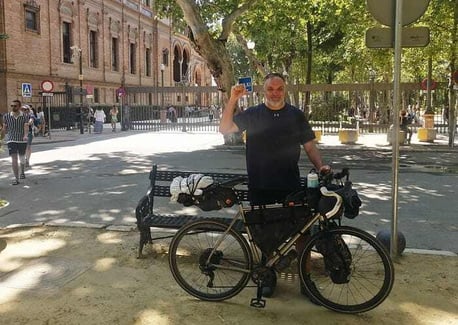
Bicycle touring is not only a great way to see the country, but also a great way to connect with the local culture and people. You will have the opportunity to explore charming villages and bustling cities, taste the culinary culture, and get a sense of the local way of life.
Bicycle touring is also an eco-friendly way to travel, and it allows you to move at a slower pace and to appreciate the small details of the area that you would never see or experience traveling by car.
If you are looking for a unique and memorable experience, a bicycle tour in Portugal and Southern Spain is definitely worth considering.
So, what are you waiting for? Make your dream bike trip a reality this year.
Leave a comment
Your email address will not be published..